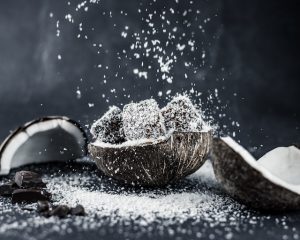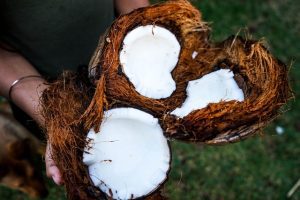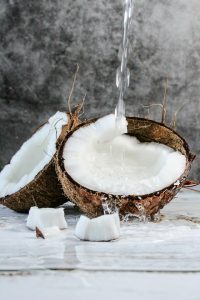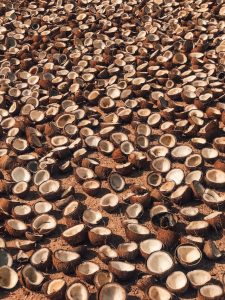As an Amazon Associate I earn from qualifying purchases.
In the world of health and nutrition, MCT (Medium-Chain Triglyceride) oil has gained significant attention for its potential benefits, including weight management, enhanced cognitive function, and increased energy levels. MCT oil is typically derived from coconut oil or palm oil and comes in various forms, one of which is MCT powder. This article delves into the process of how MCT powder is made, from the initial extraction of MCT oil to the final powder product.
A Comprehensive Guide To MCT Powder Manufacture
MCT powder is a convenient alternative to MCT oil, offering the same potential benefits while being easier to use and transport. The process of creating MCT powder involves converting liquid MCT oil into a powdered form without compromising its nutritional qualities. This article will walk you through the entire process, shedding light on the various techniques used to produce high-quality MCT powder. To learn from the before this process starts learn how is mct oil made first before reading this guide to home MCT Powders is made.

How do you make MCT Powder
Understanding MCTs and Their Benefits
Before delving into the intricate details of the manufacturing process, it’s crucial to establish a comprehensive understanding of what medium-chain triglycerides (MCTs) are and the reasons behind their popularity in the health and wellness industry. MCTs are a specific class of saturated fatty acids, differing notably in structure from their counterparts, the long-chain triglycerides typically abundant in various dietary fats. This distinction in molecular configuration is pivotal to comprehending the exceptional attributes of MCTs and the manifold advantages they confer upon the human body.
Comparative Analysis
| Property | MCTs | Long-Chain Triglycerides |
| Chain Length | Shorter | Longer |
| Absorption Rate | Rapid | Slower |
| Metabolic Conversion | Quick | Gradual |
| Energy Utilization | Efficient | Less Efficient |
| Digestive Stress | Minimal | Potential Stress |
Key Attributes of MCTs:
- Structural Distinction: MCTs encompass a shorter carbon chain in comparison to long-chain triglycerides, which enables distinctive metabolic pathways within the body.
- Rapid Absorption: Due to their abbreviated carbon chain, MCTs are rapidly absorbed by the digestive system, hastening their availability for energy production.
- Efficient Energy Conversion: The swift metabolism of MCTs leads to efficient energy conversion, making them a favoured energy source for both immediate and sustained fuel needs.
- Thermogenesis Stimulation: Consumption of MCTs has been linked to a slight increase in thermogenesis, contributing to enhanced calorie burning and potential weight management benefits.
- Cognitive Enhancement: Some studies suggest that MCTs, particularly caprylic and capric acids, might offer cognitive benefits by providing an alternative energy source for the brain.
- Digestive Ease: MCTs place minimal stress on the digestive system, making them suitable for individuals with digestive sensitivities.
- Ketone Production: MCTs are known to facilitate the production of ketones, which can be utilized as an alternative fuel source, especially during low-carbohydrate diets or fasting.
In conclusion, the unique attributes of MCTs, stemming from their molecular structure and rapid metabolism, have positioned them as a sought-after ingredient in the health and wellness realm. Their role in efficient energy conversion, potential cognitive enhancement, and compatibility with sensitive digestive systems underscores their significance in contemporary nutritional practices.

How is MCT Powder Made
MCT Oil Extraction: A Vital Prelude to MCT Powder Production
The intricate process of crafting MCT powder commences with a pivotal step: the extraction of MCT oil from its natural reservoirs, predominantly sourced from coconut oil or palm oil. These oils inherently possess varying concentrations of medium-chain triglycerides (MCTs), with coconut oil emerging as a favoured selection due to its higher MCT content compared to palm oil. The extraction procedure is a meticulously orchestrated dance that involves the separation of MCTs from the diverse spectrum of components present in the oil matrix, achieved through a technique widely known as fractionation.
Fractionation: A Technical Triumph
Fractionation stands as a fundamental technique in the world of MCT oil extraction. The process hinges on the principle that MCTs exhibit dissimilar physical properties, such as melting points, compared to long-chain triglycerides. This disparity in characteristics is the cornerstone upon which the fractionation process is built. The procedure unfolds through a series of controlled cooling and heating stages, expertly manipulating temperature gradients to facilitate the isolation of MCTs. As the oil undergoes a controlled cooling cycle, individual components crystallize at distinct points, allowing for their gradual separation. This orchestrated solidification results in the isolation of MCT-rich fractions, which are subsequently separated from the remaining components of the oil.
Envisioning the Complete Journey
For a comprehensive insight into the elaborate journey of MCT oil extraction and the subsequent transformation into MCT powder, we invite you to explore our comprehensive guide to how MCT Oil is made and produced, see it here. Our guide illuminates every step of the journey, from the initial selection of raw materials to the intricate fractionation process, culminating in the creation of the sought-after MCT oil. This resource offers an invaluable panorama of the art and science that converge to produce MCT oil, ultimately paving the way for the creation of the versatile MCT powder.
In conclusion, the journey of MCT powder production is undeniably inaugurated by the extraction of MCT oil, a process exemplified by the meticulous technique of fractionation. This initial step lays the foundation for the subsequent transformation of MCT oil into the versatile and widely embraced MCT powder, a product that continues to resonate in the realms of health, wellness, and nutrition.

Can you create mct powder
Creating MCT Powder: The Process
Creating MCT Powder: The Process” unveils the intricate journey that converts liquid MCT oil into a convenient powdered form. This transformation involves cutting-edge technology and precise techniques to ensure the preservation of MCT’s valuable properties. Join us as we delve into the meticulous steps behind this innovative conversion.
1. Spray Drying
Spray drying is one of the common methods employed to turn MCT oil into powder. In this process, the liquid MCT oil is atomized into tiny droplets and introduced into a chamber with hot air. The heat causes the liquid to evaporate, leaving behind fine MCT powder particles. This method ensures the preservation of the nutritional profile of MCTs.
2. Blending with Carriers
To enhance the solubility and texture of MCT powder, manufacturers often blend the MCT oil with carrier substances like acacia gum or tapioca starch. These carriers prevent clumping and allow for easy mixing in beverages or foods.
3. Microencapsulation
Microencapsulation involves creating a protective outer layer around each MCT particle. This not only aids in preventing oxidation but also improves the overall stability of the powder. The encapsulated MCT particles can withstand exposure to moisture, heat, and light, ensuring a longer shelf life.

MCT Powder Is Made By Drying
Advantages of MCT Powder
MCT powder offers several advantages over its liquid counterpart. It eliminates the need for refrigeration, making it more convenient for travel and on-the-go consumption. Additionally, MCT powder can be easily incorporated into recipes, shakes, and smoothies without the oily texture that MCT oil may impart.
Incorporating MCT Powder Into Your Diet
Adding MCT powder to your diet is simple and versatile. You can blend it into your morning coffee, mix it into yogurt, or sprinkle it over salads. This allows you to enjoy the potential benefits of MCTs without altering your daily routine significantly.
Factors to Consider When Choosing MCT Powder
When selecting an MCT powder product, it’s crucial to consider factors such as the source of MCT oil, the presence of additives, and the manufacturing process. Opt for products that use high-quality MCT oil and minimal additives to ensure you’re getting the best possible nutritional value.

How is MCT Oil Powder Created
Exploring Alternatives to MCT Powder
While MCT powder offers a convenient way to incorporate medium-chain triglycerides into your diet, there are several alternatives worth considering. Each alternative presents unique characteristics, making them suitable for various dietary preferences and health goals. Let’s examine some noteworthy alternatives and their key attributes:
Comparison Table:
| Alternative | Source | MCT Content | Flavour Profile | Usage |
| Coconut Oil | Coconut | Moderate | Mildly nutty | Cooking, baking |
| MCT Oil | Coconut or Palm | High | Neutral | Quick energy boost |
| C8 MCT Oil | Coconut | High (C8) | Neutral | Ketogenic diets |
| C10 MCT Oil | Coconut | High (C10) | Neutral | Sustained energy |
| Avocado Oil | Avocado | Low | Butter-like | Cooking, salads |
| Ghee Fat | Butter | Low | Rich, nutty | Cooking, flavouring |
| Butterfat | Dairy | Low | Creamy, savory | Cooking, baking |
| Heavy Cream Powder | Dairy | Negligible | Creamy | Soups, beverages |
Key Attributes:
- Coconut Oil: A versatile option with moderate MCT content, suitable for cooking and baking, but not as concentrated as MCT oil.
- MCT Oil: Offers a high MCT content, perfect for a quick energy boost and incorporating into beverages and recipes. (See the Best MCT Oil Here)
- C8 MCT Oil: Contains high levels of caprylic acid (C8), ideal for those following ketogenic diets and seeking cognitive enhancement.
- C10 MCT Oil: Rich in capric acid (C10), providing sustained energy release and minimal flavour.
- Avocado Oil: Low in MCTs but rich in monounsaturated fats, it’s a heart-healthy option for cooking and salads.
- Ghee Fat: A lactose-free alternative with a rich, nutty flavour, suitable for cooking, sautéing, and adding depth to dishes.
- Butterfat: Offers a creamy texture and savoury taste, but with limited MCT content. Great for baking and cooking.
- Heavy Cream Powder: While not a significant MCT source, it adds creaminess to soups and beverages.
Incorporating these alternatives into your diet can provide a diverse array of flavours and nutritional benefits. Choose based on your preferences, dietary goals, and culinary requirements. You may want to see which is better MCT powder vs MCT oil to see which is best for your ketone boosting keto kick.

How do they Make MCT Powder
FAQs About How They Make MCT Powder
- Is MCT powder as effective as MCT oil? While MCT powder offers similar benefits to MCT oil, the effectiveness may vary based on individual preferences and dietary needs.
- Can I use MCT powder in cooking? Absolutely! MCT powder is versatile and can be used in cooking and baking, adding a dose of energy-boosting MCTs to your dishes.
- What is the recommended daily dosage of MCT powder? The recommended dosage varies but usually ranges from 5 to 15 grams per day. Start with a smaller amount and gradually increase to assess your tolerance.
- Is MCT powder suitable for vegans? Yes, most MCT powders are vegan-friendly as they are derived from plant-based sources like coconut oil.
- Are there any potential side effects of consuming MCT powder? Some individuals may experience digestive discomfort when consuming large amounts of MCTs, so it’s best to start with a smaller serving.
Conclusion
In conclusion, MCT powder is a convenient and versatile way to incorporate the potential benefits of MCTs into your daily routine. The process of making MCT powder involves careful extraction and transformation techniques, resulting in a shelf-stable, easily mixable product that can enhance your overall well-being.
Amazon and the Amazon logo are trademarks of Amazon.com, Inc, or its affiliates.

